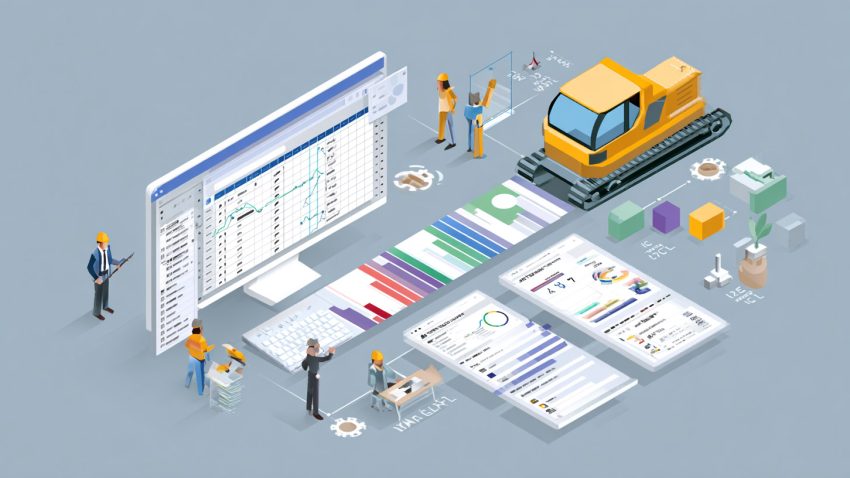Top 10 Tips for Optimizing Resources and Reducing Waste in Sustainable Construction
Table of Contents:
Learn how innovative construction materials management tools are essential for optimizing resources and reducing waste in sustainable construction efforts.
The construction industry stands at a pivotal crossroads, with sustainability no longer a choice but a necessity. As we delve deeper into the 21st century, the call for green building practices grows louder, echoing the global urgency to reduce carbon footprints and combat climate change. Central to this green revolution is the innovative management of construction materials, a critical factor in optimizing resources, minimizing waste, and ensuring the environmental integrity of construction projects. This exploration into the world of innovative construction materials management tools reveals their indispensable role in shaping a more sustainable future.

The Foundation of Sustainable Construction
Sustainable construction is not just about the end product; it’s about rethinking the entire process of building from the ground up. It challenges traditional practices, encouraging us to ask: How can we do this better, cleaner, and more efficiently? The answer often lies in the materials themselves—the backbone of any construction project. The choice, procurement, use, and disposal of construction materials can significantly impact the environment. Herein lies the opportunity for transformation, where innovative tools and technologies come into play, enabling us to manage these materials in ways that were once thought impossible.
The Role of Innovative Tools in Materials Management
Modern construction projects are complex webs of logistics and planning, where every brick, beam, and bolt counts. Managing these components efficiently requires more than just good intentions; it requires smart solutions. Enter innovative construction materials management tools, software, and platforms designed to streamline the procurement, storage, usage, and recycling of building materials. These tools offer a multitude of benefits, crucial for any project aiming for sustainability.
Resource Optimization
At the heart of sustainable construction is the concept of resource optimization—using what you need without excess or waste. Innovative materials management tools provide detailed insights into project requirements, enabling precise ordering and minimizing surplus materials that often end up as waste. This not only conserves resources but also reduces the environmental impact associated with producing and transporting unnecessary materials.
Waste Reduction
Waste reduction is a critical aspect of sustainable construction. Through advanced tracking and management capabilities, these tools help identify opportunities for recycling and reusing materials, significantly cutting down on waste. For instance, by accurately tracking material usage and leftover quantities, construction projects can repurpose materials for other jobs, donate unused supplies, or recycle materials, thereby contributing to a circular economy.
Enhanced Efficiency and Cost Savings
Efficiency in construction goes hand in hand with sustainability. By optimizing the use of materials, projects can avoid over-purchasing and reduce costs associated with waste disposal. Furthermore, these tools facilitate smoother operations on-site, reducing the time and energy spent managing materials. The cumulative effect of these efficiencies can lead to substantial cost savings, making sustainable practices not just environmentally responsible but also economically viable.
Improved Data Accuracy and Decision Making
Innovative management tools harness the power of data to provide accurate, real-time information about materials. This enables project managers to make informed decisions, foresee potential issues, and adjust plans proactively. With the ability to track the lifecycle of materials from procurement to installation, these tools offer a level of insight that was previously unattainable, ensuring that sustainability goals are met throughout the project.
Fostering Collaboration and Transparency
Sustainable construction is a collaborative effort, requiring clear communication and coordination among all stakeholders. Innovative materials management tools enhance transparency, allowing all parties to access up-to-date information on material usage, availability, and environmental impact. This fosters a culture of accountability and collaboration, where everyone is aligned with the project’s sustainability objectives.
Success Stories: Real-World Applications
Across the globe, numerous construction projects have leveraged innovative materials management tools to achieve remarkable sustainability outcomes. For example, a high-rise development project in a major city utilized a digital platform to track the sourcing and usage of recycled steel, significantly reducing its carbon footprint. Another project, a residential community designed for sustainability, used software to manage locally sourced materials, ensuring minimal transportation emissions and supporting local economies.
Top 10 Strategies for Resource Efficiency and Waste Minimization in Green Building Practices
1. Embrace Digital Inventory Management
Adopt digital inventory management tools to keep a real-time track of your materials. This approach minimizes overordering and excess inventory, significantly reducing waste and ensuring materials are used efficiently. Tools that offer insights into material lifecycle help in making informed decisions, saving costs, and promoting sustainability.
2. Prioritize Material Reuse and Recycling
Before disposing of materials, evaluate opportunities for reuse and recycling. Many construction materials, such as metal, wood, and concrete, can be recycled or repurposed for different projects, reducing the demand for new materials and minimizing waste.
3. Implement Lean Construction Principles
Lean construction methodologies focus on minimizing waste and maximizing value. By adopting lean principles, such as value stream mapping and just-in-time delivery, construction projects can significantly reduce unused materials and optimize resource usage.
4. Use Prefabricated and Modular Components
Prefabrication and modular construction allow for more precise material usage and less waste. Components made in a controlled factory setting ensure higher quality and reduce the need for corrections on-site, leading to more efficient material use.
5. Conduct Regular Waste Audits
Perform waste audits to understand where and why waste is generated. Identifying the sources of waste can help in implementing targeted strategies to reduce it, such as adjusting procurement practices or improving on-site handling and storage.

StruxHub
Discover how StruxHub can revolutionize your construction management. Contact us today!
6. Opt for Sustainable Materials
Choose materials with a lower environmental impact, such as recycled content, renewable resources, or those harvested sustainably. Using sustainable materials not only reduces waste but also decreases the carbon footprint of your construction projects.
7. Implement Just-in-Time (JIT) Delivery Systems
Just-in-Time delivery systems ensure materials arrive exactly when needed, reducing the risk of damage and loss, as well as the need for extensive on-site storage. This approach minimizes material waste and helps maintain a clutter-free construction site.
8. Educate Your Team
Educate your construction team about the importance of material conservation and efficient usage. A team that understands the value of sustainability is more likely to adopt practices that reduce waste and optimize resource use.
9. Utilize Advanced Software for Project Management
Advanced project management software can dramatically improve planning accuracy, allowing for better forecasting of material needs and reducing the likelihood of excess ordering. These tools can integrate with other systems to provide a comprehensive view of material management.
10. Collaborate with Suppliers on Sustainable Practices
Work closely with your suppliers to identify opportunities for reducing packaging, returning unused materials, or supplying in quantities that match the project’s needs closely. Collaborative efforts can lead to innovative solutions that benefit all parties involved and the environment.
By implementing these tips, construction projects can significantly enhance their sustainability profile. Managing materials innovatively not only optimizes resources and reduces waste but also contributes to the broader goal of creating a more sustainable, environmentally friendly construction industry.
The Future of Sustainable Construction
Looking ahead, the role of innovative construction materials management tools in sustainable building efforts is set to expand. As technology advances, we can anticipate even more sophisticated solutions, from AI-powered analytics for predicting material needs to blockchain for ensuring the ethical sourcing of materials. The future of construction is one where sustainability is embedded in every decision, supported by tools that make green building practices not just aspirational but achievable.
Embracing Change for a Sustainable Tomorrow
The journey toward sustainable construction is an ongoing process, one that requires commitment, innovation, and a willingness to embrace change. By integrating innovative construction materials management tools into their practices, builders and developers can take significant strides toward minimizing environmental impact, conserving resources, and paving the way for a more sustainable future.
As we continue to push the boundaries of what’s possible in sustainable construction, the importance of these tools becomes ever more apparent. They are not just facilitators of green building practices; they are catalysts for change, empowering the construction industry to lead the way in environmental stewardship. The path to a sustainable future in construction is clear, and with the help of innovative materials management tools, it’s a path that we can walk with confidence.
The adoption of innovative construction materials management tools is essential for optimizing resources and reducing waste in sustainable construction efforts. These tools are the key to unlocking the full potential of green building practices, ensuring that every project contributes positively to the planet. As we look to the future, let us continue to innovate, collaborate, and strive for sustainability in every beam we place and brick we lay. The construction industry has a pivotal role to play in shaping a sustainable world, and with the right tools at our disposal, there’s no limit to what we can achieve. Let’s build a greener, cleaner, and more sustainable future, together.
StruxHub is a construction project management software that helps you manage projects from start to finish. It offers features like task management, document management, and communication tools. StruxHub can help you save time and money, improve communication, collaboration, and decision-making.
To learn more about how StruxHub can streamline your construction management processes, request a demo today. By completing our form, you’ll hear from our team soon to discuss how StruxHub can help you:
- Schedule construction material deliveries with your trades
- Coordinate construction site resources and on-site logistics
- Digitize work permits and inspection forms
- Communicate and track P6 and Excel schedules
- Broadcast announcements to all construction workers
Don’t miss out on the opportunity to optimize your construction management processes with StruxHub. Sign up for a free demo today.



